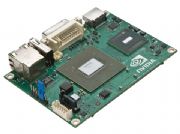Once you've determined the type of desktop system you want--a compact PC, a budget system, a mainstream all-purpose model, or a performance crackerjack--you need to know what components to look for. The processor and graphics chip you choose will determine many of your machine's capabilities, as will the system's memory and hard drive. Understanding those components will help you get the performance you need, without paying for things you don't. (Our buying guide includes further shopping tips for purchasing a desktop PC.)
You'll also want to consider details like the layout of the case, which can also make the difference between a pleasant workstation and a nightmare PC.
Processor
The CPU is one of your PC's most important components. The processor you choose is likely to determine your PC's shape and size, and will definitely determine its price. Generally, the higher the CPU clock speed, the faster the performance you may see--and the higher the price. A 3.46GHz Core i5-670 PC will trounce a 2.93GHz Core i3-530 system, but you'll pay nearly twice as much for the faster CPU. Another spec to watch is cache size: More is better, here: Core i3 and Core i5 parts have 4MB caches, while performance-geared Core i7 chips have 6MB or 8MB caches.
Compact PCs and some all-in-ones use relatively puny netbook or notebook processors. Though these CPUs deliver weaker performance than desktop processors, they're also smaller and generate less heat, which makes them ideal for small machines. A PC packing an Atom processor should be fine for basic word processing, Web surfing, and limited media playback--but little more.
 Intel's new Clarkdale line of Core i3 and Core i5 desktop processors tend to appear on systems in the budget desktop and mainstream desktop PC categories. Most users will find something they like in the Core i3 and Core i5 lines, as these CPUs offer dual-core performance at palatable price points. Core i3 chips are the cheaper, lower-powered models, so you'll generally find them in cheaper machines.
Intel's new Clarkdale line of Core i3 and Core i5 desktop processors tend to appear on systems in the budget desktop and mainstream desktop PC categories. Most users will find something they like in the Core i3 and Core i5 lines, as these CPUs offer dual-core performance at palatable price points. Core i3 chips are the cheaper, lower-powered models, so you'll generally find them in cheaper machines.
The quad- and six-core Core i7 targets users who need a real workhorse processor. If you play high-end games or edit hours of audio or video, you'll benefit from the Core i7. The lowliest Core i3 CPU can easily handle basic computing tasks, so stay within a reasonable price range when possible.
Desktop PCs use either Intel or AMD processors. Intel currently holds the performance crown, but AMD has priced its dual-core, quad-core, and six-core chips aggressively. If you're looking for quad-core performance on a budget, AMD-based offerings are certainly worth a look.
Graphics Cards
The GPU (graphics processing unit) is responsible for everything you see on your display, whether you play games, watch videos, or just stare at the Aero desktop baked into Windows 7.
 If you aren't interested in gaming on your PC, integrated graphics built onto the motherboard--or in the CPU itself with Intel's new Core i3 and Core i5 Clarkdale chips--is the way to go. Integrated graphics help keep a system's cost low, and they deliver enough power to run simple games or high-definition Flash video. Intel's integrated graphics chips are widely used, but some PCs include an nVidia Ion graphics chip, which offers superior integrated video performance.
If you aren't interested in gaming on your PC, integrated graphics built onto the motherboard--or in the CPU itself with Intel's new Core i3 and Core i5 Clarkdale chips--is the way to go. Integrated graphics help keep a system's cost low, and they deliver enough power to run simple games or high-definition Flash video. Intel's integrated graphics chips are widely used, but some PCs include an nVidia Ion graphics chip, which offers superior integrated video performance.
If you plan to render your own high-definition content or play BioShock 2, you'll need a discrete graphics card. Such cards come installed in a PCIe x16 slot on your motherboard and deliver significantly more power than integrated graphics do. Both AMD and Nvidia offer plenty of options to choose from. AMD's Radeon HD 6800 series of graphics cards offer excellent performance, in the $180 to $250 price range. Nvidia's GeForce GTX 580 is currently the fastest GPU that money can buy, aimed expressly at gaming enthusiasts with its $500 price tag.
Variables such as power consumption, size, and the brand of your motherboard (which may limit which cards you can use) will help determine which GPU is right for you. Gamers with deep pockets can also opt for a multiple-graphics-card setup using either Nvidia's SLI or AMD's CrossFire technology, either of which sets multiple cards to work in tandem for vastly improved performance.
Source: http://feeds.pcworld.com/click.phdo?i=2ae78ea8060ae7efd9a304219be0520a
silver touch lamp horse touch lamp touch lamp converter touch lamp bulbs touch control table lamp
Keine Kommentare:
Kommentar veröffentlichen